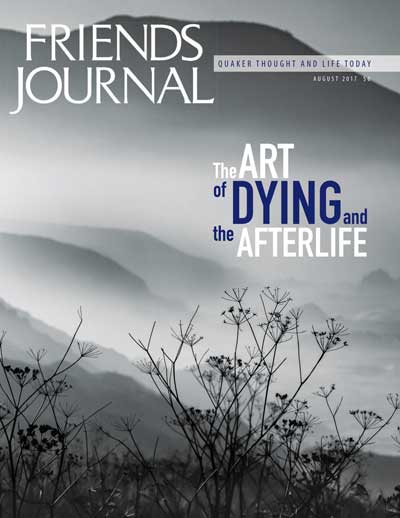Through the course of civilization, we humans have gotten ever better at focusing our intelligence on the mysteries of the natural world. We’ve tested, mastered, and applied knowledge to phenomena that were once the province of magic.
Yet one of the most fundamental mysteries of our existence remains stubbornly opaque: what happens to us after death. Someone looking at the hard science might conclude that death is the final shutdown and that there is no “after” after it: neurotransmissions stop, blood coagulates, and the body begins a rapid deterioration process. Yet many of us continue to wonder if there is more. We have glimpses in the accounts of those back from near-death experiences. The sensitive among us will swear they’ve felt the presence of departed loved ones. Our various religious traditions provide answers, if we can believe on faith alone. Mysteries abound.
You might expect Quakerism, a tradition borne of an insistence on the authority of direct experience, to downplay unanswerable questions. To be sure, early Friends fully believed in the redemptive power of Jesus’s death and Christian claims to eternal life, but I rarely see them get caught in the metaphysics of post-death experiences. They were a practical bunch. You can find more clues about a Quaker theology of death by watching how they approached it in life.
One clue comes from Quaker burial grounds. They were astoundingly plain, little more than designated fields for unmarked graves. Quaker theology: we are all equals in death; the skin and bones of our bodies are unimportant. Over time, small tombstones crept in, but these weren’t protection: more than one burial ground has been repurposed for the more pressing needs of the living. Theology: we don’t physically venerate the dead.
We could also look to what we could call the Quaker art of dying: a centuries-old lived culture that accepts death. There are our oft-retold stories of faithful Friends facing approaching death with calm dignity, assured there was nothing to fear on the other side. The clear, if unstated, theology is that there is something more after death: an afterlife that we need not fear.
This issue of Friends Journal brings Friends together to share their experiences of living with death. There are moments when you’ll want to have tissues handy. After all, it is hard not to see echoes of one’s own departed loved ones in these stories. But the process of reconciling sorrow brought these Friends to a deeper understanding not only of death but of life, and how to live life as Quakers.
Friend Shannon Zimmerman found that the answers she searched for in books were to be found, instead, at her dying father’s bedside. When a teenaged Betsy Blake blamed God for not healing her sister, her mother gently corrected her that God had done the healing, “just not in the way we expected.” After Robert Stephen Dicken’s mother died, he realized her passage was not unlike meeting for worship: an encounter with a welcoming Jesus guiding us to the Inward Light. And Michael Resman had an mystical experience of God in meeting for worship itself, giving him a clarity of purpose which has since guided his life.
In recent months, Friends Journal has been blessed with many more fascinating submissions than we can fit in the pages of our print magazine. In August our website will feature four online-only articles on death and dying that are well worth your time. We’d love to hear your stories and your reactions in the comment threads of the website.



Comments on Friendsjournal.org may be used in the Forum of the print magazine and may be edited for length and clarity.